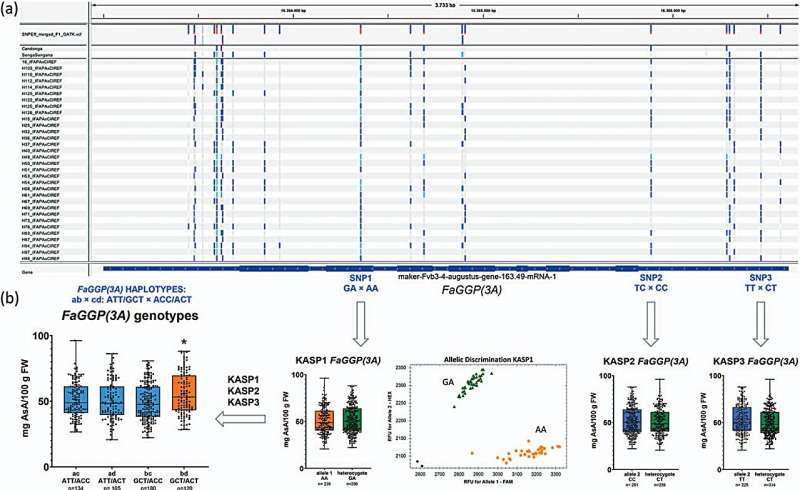This article has been reviewed according to Science X's editorial process and policies. Editors have highlighted the following attributes while ensuring the content's credibility:
fact-checked
peer-reviewed publication
trusted source
proofread
Decoding the genetics of ascorbic acid: A deep dive into strawberry's Vitamin C content and its environmental factors

Vitamin C, also known as ascorbic acid (AsA), is a prevalent antioxidant found in various organisms, notably plants and animals. Functionally, AsA plays a variety of roles, from enzyme cofactor to safeguarding against oxidative damage during photosynthesis or external stresses in plants.
Due to genetic mutations of the last biosynthesis step, humans cannot synthesize AsA internally and rely on dietary intake, primarily from plants like fruits and vegetables. There are diverse biosynthetic pathways for AsA production in plants, with the Smirnoff-Wheeler pathway being predominant in many species. However, alternative pathways and their relevance differ across species and developmental stages. Moreover, the transport and regeneration of AsA are vital for maintaining cellular balance.
Breeding efforts focused on important targets like maintaining high yield and increasing resistance to pests for strawberry may inadvertently affect its AsA content. Although the genetic control of fruit AsA content is well understood in some fruits and the 232×1392 biparental population of strawberry, understanding the AsA content of strawberries could improve the nutritional quality and stress tolerance.
In January 2023, Horticulture Research published a research paper entitled "QTL analysis for ascorbic acid content in strawberry fruit reveals a complex genetic architecture and association with GDP-L-galactose phosphorylase."
In this study, researchers first conducted a preliminary analysis of 35 lines from the 'Candonga' (Can)×'Senga Sengana' (SS) during the 2016–2017 season, which showed that there was a great deal of variation in ascorbic acid (AsA) content, suggesting the potential for QTL mapping. This prompted an expanded study during 2017–2018, where AsA content was assessed in 113 F1 lines grown across five European countries (Poland, Germany, France, Italy and Spain).
The results demonstrated both genetic and environmental influences on AsA content , but there was a positive correlation in AsA content across countries, indicating that genotypes generally maintained their AsA levels irrespective of the environment and a large genetic effect that might facilitate QTL detection.
The Can×SS linkage map was constructed using SNP markers genotyped in the parental and 126 F1 lines, AsA content in each country and the average in all of them was used in combination with 6,974 markers for quantitative trait locus (QTL) analysis. QTL mapping identified several regions associated with AsA and dry matter (DM) content, with some QTLs stable across multiple countries.
Environmentally stable QTLs for AsA content were detected in linkage group (LG) 3A, LG 5A, LG 5B, LG 6B and LG 7C. These findings suggest a complex interplay of genetic and environmental factors determining AsA levels in strawberries.
Researchers further employed the F. × ananassa 'Camarosa' v1.0 genome to search within 1-LOD intervals, in order to identify potential genes linked to ascorbic acid (AsA) QTLs. These intervals enclosed numerous transcripts with two notable candidate genes discovered on LG 3A associated with 19% variance. These genes showed homology to monodehydroascorbate reductase (MDHAR) and GDP-L-galactose phosphorylase (GGP).
In another finding, two homoeologous genes were found in homoeologous regions of LGs 5A and 5B. An additional seven candidate genes were identified across other QTL intervals. To verify the gene expressions in ripe strawberry fruit, RNAseq data was mapped to the 'Camarosa' reference genome, revealing that five of the nine genes displayed significant expression.
Further analysis using qRT-PCR confirmed that the gene FaGGP(3A) and FaPHT4;4(7C) plays a pivotal role in determining AsA content in strawberries.
A further research strand investigated the association of different FaGGP(3A) haplotypes with AsA content, and the KASP markers on FaGGP(3A) were not universally predictive of AsA content in broader germplasm. However, SNP on the QTL qAsAFW-3A proved to be useful for marker-assisted selection, showing potential in predicting AsA content in diverse strawberry accessions.
In conclusion, this study identified quantitative trait loci (QTLs) related to AsA content and pinpointed candidate genes like FaGGP(3A) could be integral in regulating AsA levels. These findings pave the way for selectively breeding strawberry cultivars with heightened AsA content, enhancing their nutritional benefits.
More information: Pilar Muñoz et al, QTL analysis for ascorbic acid content in strawberry fruit reveals a complex genetic architecture and association with GDP-L-galactose phosphorylase, Horticulture Research (2023). DOI: 10.1093/hr/uhad006
Journal information: Horticulture Research
Provided by NanJing Agricultural University





















